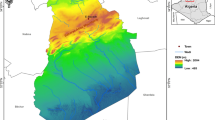Abstract
There are two significant reasons for the uncertainties of water demand. On one hand, an evolving technological world is plagued with accelerated change in lifestyles and consumption patterns; and on the other hand, intensifying climate change. Therefore, with an uncertain future, what enables policy-makers to define the state of water resources, which are affected by withdrawals and demands? Through a case study based on thirteen years of observation data in the Zayandeh Rud River basin in Isfahan province located in Iran, this paper forecasts a wide range of urban water demand possibilities in order to create a portfolio of plans which could be utilized by different water managers. A comparison and contrast of two existing methods are discussed, demonstrating the Random Walk Methodology, which will be referred to as the “On-uncertainty path”, because it takes the uncertainties into account and can be recommended to managers. This OnUncertainty Path is composed of both dynamic forecasting method and system simulation. The outcomes show the advantage of such methods particularly for places that climate change will aggravate their water scarcity, such as Iran.
Similar content being viewed by others
References
Araghinejad, S., Burn, D., and Karamouz, M., Longlead probabilistic forecasting of streamflow using ocean atmospheric and hydrological predictors, J. Water Resources Res., 2006, vol. 42, no. 3.
FAO. Food and Agriculture Organization of the United Nations, 2008, http://wwwfaoorg/nr/water/aquastat/ countries_regions/IRN/indexstm
Finucane, M.L., Peters, E., and Slovic, P., Judgment and Decision Making: The Dance of Affect and Reason, Cambridge, UK: Cambridge Univ. Press, 2003.
Frederich, K. and Major, D., Climate change and water resources, J. Climate Change, 1997, vol. 37, pp. 7–23.
Georgakakos, A., Yao, H., Kistenmache, M., Georgakakos, K., Graham, N., and Cheng, F.-Y., Value of adaptive water resources management in Northern California under climatic variability and change: Reservoir management, J. Hydrol., 2012, vols. 412–413, pp. 34–46.
Haie, N. and Keller, A., Macro, Meso, and Micro-Efficiencies in water resources management: A new framework using water balance, J. American Water Resources Association, 2012, vol. 48, no. 2 pp. 235–243.
Haie, N. and Keller, A.A., Macro, meso, and microefficiencies and terminologies in water resources management: a look at urban and agricultural differences, Water Int., 2014, vol. 39, no. 1 pp. 35–48.
Haie, N., Machado, G.J., Pereira, R.M., and Keller, A.A., Effective efficiency in water resources management using efficiency elasticity index, Water and Environ. J., 2011, vol. 25, no. 4 pp. 532–539.
Heltberg, R., Siegel, P., and Jorgensen, S., Addressing human vulnerability to climate change: Toward a “noregrets” approach, Global Environ. Change, 2009, vol. 19, no. 1 pp. 89–99.
Heneker, T., Lambert, M., and Kuczera, G., A point rainfall model for risk-based design, J. Hydrol., 2001, vol. 247, pp. 54–71.
Koutsoyiannis, D., Nonstationarity versus scaling in hydrology, J. Hydrol., 2006, pp. 239–254.
Loucks, D.P., Van Beek, E., Stedinger, J.R., Dijkman, J.P., and Villars, M.T., Water Resources Systems Planning and Management: an Introduction to Methods, Models and Applications, Paris: UNESCO, 2005.
Madani, K. and Marino, M., System dynamics analysis for Mana in Iran’s Zayandeh-Rud River basin, J. Water Resources Management, 2009, vol. 23, pp. 2163–2187.
Madsen, H., Mikkelsen, P., Rosbjerg, D., and Harremoe’s, P., Regional estimation of rainfall intensityduration-frequency curves using generalized least squares regression of partial duration series statistics, J. Water Resources Res., 2002, vol. 38, no. 11 pp. 21–1–21–11.
Marien, M., Futures studies in the 21st Century: a reality-based view, J. Futures, 2002, vol. 34, pp. 261–281.
Molle, F. and Mamanpoush, A., Scale, governance and the management of river basins: A case study from Central Iran, J. Geoforum, 2012, vol. 43, pp. 285–294.
Neufville, R. and Scholtes, S., Flexibility in Eng. Design, London: The MIT Press Cambridge, Massachusetts, 2011.
Ramirez, N., Valuing flexibility in infrastructure developments: The Bogota water supply expansion plan, MSc Thesis, Massachusetts Institute of Technology, 2002.
Savage, S., The flaw of average, Harvard Business Rev., 2002, vol. 80, no. 11 pp. 20–21.
SCI. Statistical Center of Iran. http://wwwamarorgir Defaultaspx?tabid=133, Cited 2013
Slovic, P., Finucane, M., Peters, E., and MacGregor, D., Risk as analysis and risk as feeling: some thoughts about affect, reason, risk, and rationality, J. Risk Analysis, 2004, vol. 24, no. 2 pp. 311–322.
UNESCO. Managing Water under Uncertainty and Risk, The United Nations World Water Development Rep. 4, vol. 1, Paris: UNESCO, 2012.
Author information
Authors and Affiliations
Corresponding author
Additional information
The article is published in the original.
Rights and permissions
About this article
Cite this article
Ferdosian, I., Haie, N. Random walk forecast of urban water in Iran under uncertainty. Water Resour 43, 200–206 (2016). https://doi.org/10.1134/S009780781612006X
Received:
Published:
Issue Date:
DOI: https://doi.org/10.1134/S009780781612006X




